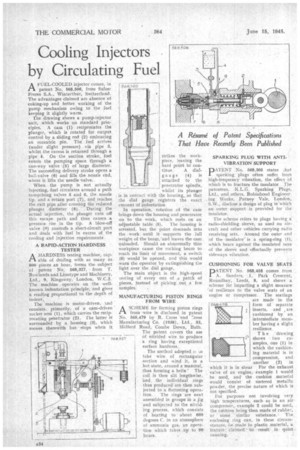Cooling Injectors .
Page 36

If you've noticed an error in this article please click here to report it so we can fix it.
by Circulating Fuel
AFUEL-COOLED.injector collies, in patent No. 568,506, froth Sulzer Freres S.A., Winterthur, Switzerland. The advantages claimed are absence of coking-up and better working of the pump mechanism owing to the fuel keeping it slightly warm.
The drawing shows a pump-injector unit, which works on standard principles. A cam (1) reciprocates the plunger, which is rotated for output control by a sliding rod (2) embracing an eccentric pin. The fuel arrives (under slight pressure) via pipe 3, whilst the excess. is returned through a pipe 4. On • the suction stroke, fuel enters the pumping space through a one-way valve (5) of large diameter. The succeeding delivery stroke opens a ball-valve (6) and fills the nozzle end, where it lifts the needle valve.
When the pump is not actually injecting, "fuel circulates around a path comprising valves 5 and 6, the nozzle tip, and a return port (7), and reaches the exit pipe after crossing the reduced plunger diameter (8). During the actual injection, the plunger tuts off this escape path and thus causes a pressure rise in the tip. A blow-off valve (9) controls a short-circuit port and deals with fuel in excess of the cooling and injection requirements A RAPID-ACTION HARDNESS TESTER
AHARDNESS testing machine, capable of dealing with as many as 800 pieces an hour, forms the subject of patent No. 568,327, from T. Rowlands and Linotype and Machinery, Ltd., 9, Kingsway, London, W.C.2. The machine operates on the wellknown indentation principle, and gives a reading proportional to the depth of indent.
The machine is motor-driven, and consists, primarily., of •a cam-driven rocker arm (1), which carries the reciprocating penetrator (2). The latter iS surrounded by a housing .(3), which moves therewith but stops when it
strikes the workpiece, leaving the hard point to continue, A dialgauge (4) is attached to the penetrator spindle, whilst " its plunger is in contact with the housing, so that he dial gauge registers the exact amount of indentation. . .
In operation, rotation of the cam brings down the housing and penetrator on to the work, which rests on an
adjustable table. (5). The •housing is arrested, but the point descends into the work until it supports the . lull weight of the beam, 'and leaves the cam unloaded. • Should an abnormally thin workpiece cause the rocking beam to reach its limit of movement, a switch (6) would be opened, and this would warn the operator by extinguishing tile light over the dial gauge.
The main object is the high-speed resting of every one of a patch of pieces, instead of picking" out a few samples.
MANUFACTURING PISTON RINGS FROM WIRE
ASCHEME for forming piston rings from --wire is diseloSed in patent No. 568,479 by R. Cross and -.toss Manufacturing Co. (1938), Ltd., 33, Midford Road, Combe Down, Bath. The patent covers the use of nitrided wire to produce a ring having exceptional surface hardness.
The method adopted I, Lo take wire of rectangular section and wind it, in a hot state, around a mandrel, thus forming a helix' The coil is then slit lengthwise, 'mid the individual rings thus produced are then subjected to a flattening opera.'
tion. The rings are next assembled in groups in a jig and subjected to the nitricting process, which consists of heating to about 600 degrees C. in an atmosphere of ammonia gas, an operation which takes up to 90 hours.
SPARKING PLUG WITH ANTIVIBRATION SUPPORT pATENT No. 568,305 states Lhat sparking plugs often suffer from high-frequency vibration, the effect of which is to fracture the insulator The patentees, K.L.G, Sparking Plugs, Ltd., and others, Robinhood Engineer jug Works, Putney Vale, London, SW., disclose a design of plug iri which an outer support is provided for the insulator.
The scheme refers to plugs having a.' radio-shielding sleeve, as used on aircraft and other vehicles carrying radio receiving sets. Around the outer end of the insulator' is a spring-ring (1). which bears against the insulated bore of the sleeve and effectually prevents sideways vibration,
CUSHIONING FOR VALVE SEATS
PATENT No. 568,458 comes from A. Sanders, 1, Park Crescent, Rotindhay, Leeds, 8; and shows a scheme for imparting a slight measure of resilience to the valve seats of an engine or compressor. The seatings are made in the form of separate inserts, and are cushioned by an intermediate member having a slight resilience.
The 'drawing 4' shows two examples, one (1) in which the cushioning material is in compression, and another (2) in which it is in shear For the exhaust valve of an engine, example 1 would be used, and the cushion material would consist of sintered metallic powder, the precise nature of which is not specified.
For purposes not involving very high temperatures, such as in an air compressor, example 2 could be used, the mishion being then made of rubber, or shine similar substance."' The enclosing ring can, in these circumstances., be made in plastic material, a feature. claimed to -result in quiet. running.
S68-158




















































